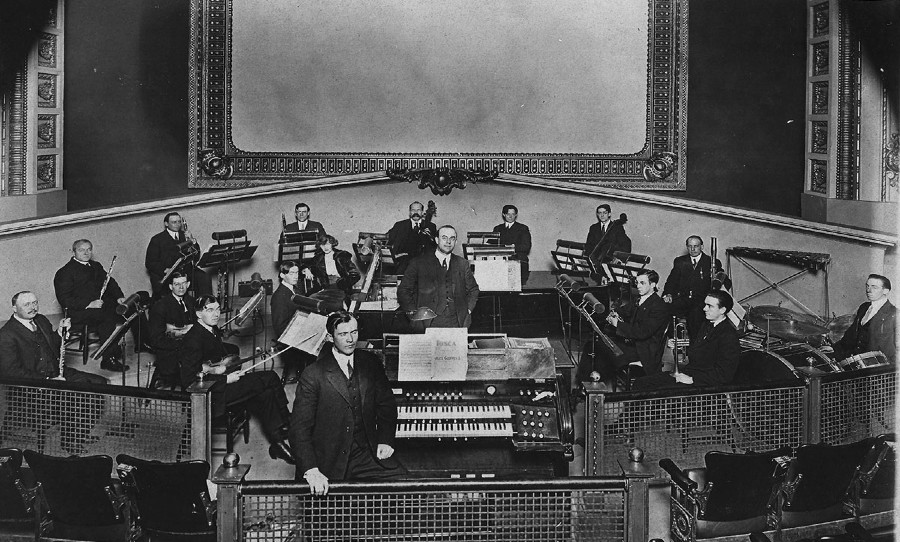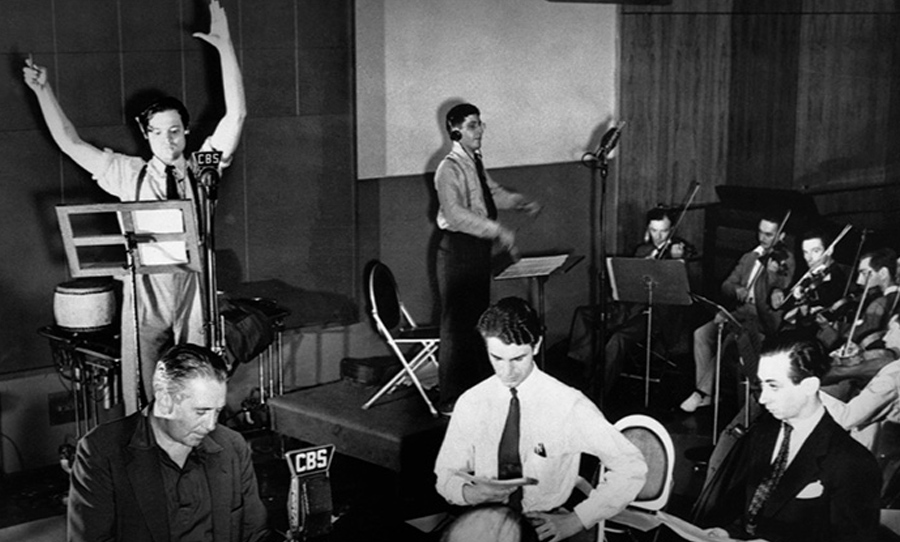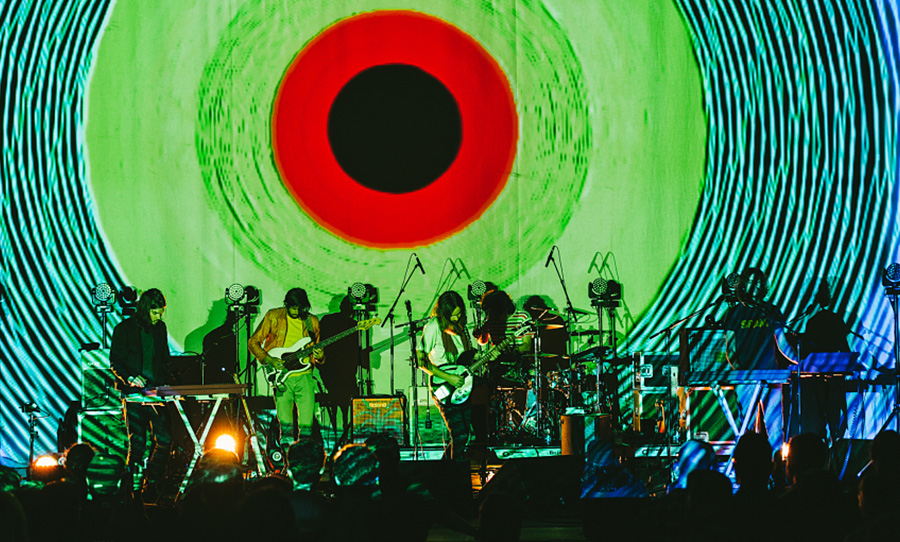You are going to experience the history of sound in film. Hear a ‘Talkie’ for the first time, sing along to a Golden Age musical and marvel at genre-defying synth sound effects.
It is the early 1900s: a world of phonographs, zoopraxiscopes and kinetoscopes. To you, a marriage of sound and film seems impossible. Sound technology is in its absolute infancy. Recorded music can not yet be amplified, played for long periods of time, or synced with moving image. Sound effects are just beginning to be imagined.
Take your seat, the ‘Silent’ era is about to begin.
You follow the actor’s dialogue on title cards and hear the film — its score and many sound effects — thanks to a large orchestra that plays that the front of the theatre.

Cut to 1920. A scientist called Lee De Forest incorporated sound-on-film technology — which sees sound being printed onto the actual film strips — but has also invented the Audion tube to magnify sounds to fill a packed theatre. Soundtracks and sound effects can now be synchronized, amplified and played for more than five minutes at a time. Between 1920 and 1924 the De Forest PhonoFillm Corporation churns out over 1000 short sound films from vaudeville acts to plays to speeches, which you see at your local theatre.
De Forest attempts to sell this technology to industry giants at the time: Universal Studios and Paramount, but they have no interest in disrupting the silent film boom with something as frivolous as sound.
There is one small start-up studio — you’ve never even heard of it — that is willing to take the risk. They are called Warner Brothers Pictures. Warner Brothers invests in a device called the Vitaphone, which they use to synch musical scores with film in a major film theatre for the first time. In 1926, they premiere this technology in a film called Don Juan. It was such a success, that you hear critics call it the 8th wonder of the world.
You believe sound will be a fleeting fad. There’s no way production companies will build entire studios to record sound, or equip all theatres with speakers to handle recorded music!
In 1927 all of this changes. You see the latest Warner Brothers film The Jazz Singer and for the first time, you hear a piece of recorded dialogue. This isn’t like the news pieces or speeches that often play before the film begins, this is drama unfolding before your eyes, a voyeuristic experience. You know will change cinema forever.
1927 – 1930: Look who’s talking
Enter: The ‘Talkies’.
Warner Brothers makes the first-ever feature-length ‘talkie’ film in 1928 called Lights of New York. The talkies attract thousands and thousands of audiences members – yourself included – and between 1927 and 1928 studios collectively invest an estimated $300 million into sound conversion, which is four times the worth of the entire film industry as a whole.
It is because of sound that Hollywood is able to survive the first wave of The Great Depression. Had it not been for the bold moves of Warner Brothers to invest in sound conversion before the stock market crash in 1929, sound in film may not have been possible for decades.
Silent films are entirely eradicated by 1930. Sound is here to stay.
The 1930s – Scores to tell a story, sound effects and synching to animation
It is 1933, and sound is a well established standard in all films. Premiering in theatres now is King Kong — which would later be known as the first film to employ recorded sound effects and compose a thematic score.
The score is composed by Max Steiner and is so much more than background music. It is a musical illustration that enhances the narrative. It is complex and has dimension, for the first time there are musical motifs and they help bring a reality to the fantastical scenario you are watching on the screen.
To you, Kong’s roar is mind-blowing. While it is believably animalistic, it is also otherworldly. You learn it has been produced from field recordings of a lion and a tiger made by Murray Spivack. He used reverse playback and altered speeds, overlapping the sounds to make an ambiguous and terrifying sound. Accompanied by the brutality of the score, watching Kong tear apart New York sends shivers down your spine.
In the same year, Walt Disney introduces Three Little Pigs, which is among the first animated musicals to take to the big screen.
It’s also in colour.
Disney has released a few animated musicals as a part of their Silly Symphonies cartoons. As animation is unburdened by the awkward logistics of live-action shooting, Disney’s cartoons combine sound and image both asynchronously and with perfect frame by frame synchronisation.
The musical has a song motif, which has become a common occurrence since composers realised the intense emotional impact sound can have on the viewers. You exit the theatre with Frank Churchill’s ‘Who’s Afraid of the Big Bad Wolf‘ stuck in your head.
The 1940s – Real sound
It is 1941 and the lights in the cinema dim as a new movie begins. It’s called Citizen Kane.
The first thing you notice about the film is how real it sounds. The sound is so accurate it appears to move with the characters — when they turn away from the camera their dialogue is muffled, characters in the background have their voices softened, while characters in the foreground are louder. Each space has its own sense of depth, reverberation and point of view. Each image is energised by the sound.
When the film ends, you learn the 25-year-old director Orson Welles was inspired by the deep focus space of radio dramas — which are currently all the rage. This radio realism is achieved by using ADR and extensive sound mixing in post-production.
Citizen Kane does not do very well in the box office that year, and you doubt you’ll ever hear anything about it again. As a sort of antithesis to classic Hollywood scoring that you’ve heard in comedy and romance, The Maltese Falcon has catalysed what you’ve heard people call ‘Film Noir’.
It’s a dark film, its score totally defies the tonal tradition you’re used to hearing. It is reminiscent of the uncertainty and displacement you’re feeling in the midst of the Second World War. Unlike other classic films, the music only underscores important scenes in the film, leaving most of the movie eerily silent.
When the film ends you read a review by prominent music critic Lawrence Morton, according to Morton the music – composed by Adolph Deutsch is “bold, complex and thick textured…dissonant, sonorous, fragmentary in thematic material and rich in developmental processes”.
The 1950s – The Golden Age of Cinema: The Musical
Lights, camera, action! It’s the Golden Age of Cinema!
WWII has come to an end and there is an economic boom like you’ve never seen before. With cutting edge colour grading from Technicolour everyone is for a bright, lavish bit of entertainment. Two words are buzzing in everyone’s ears.
Movie. Musicals.
Singin’ In the Rain is the purest form of this: a musical about musicals. Its metafictional tone is so successful because of its clever sound design. It is carefully established in reality and the fictional world, it’s satiric and it’s the music that helps further the plot. This is pushing the role of music even further in the film world — from background noise to motif to propellor of story.
When Singing in the Rain begins to play and Gene Kelly leaps onto that lampost, you can’t help as a viewer to feel lifted as well: carefree, lighter, happy.
The 1960s – Dolby surround sound and Foley is born
Stanley Kubrick releases an epic historical drama called Spartacus. The film is a spectacle, and while you are blown away by the sheer volume of the battle cries and swooping score, you can’t help but notice some of the more intimate sounds of the film too.
This is all thanks to Jack Foley, who has just pioneered the art of Foley. After Kubrick decided the sound of his soldiers armour sounded too fake, Foley saved the crew from an expensive two-day reshoot by recording the sound of his keys jangling, editing it, and adding it in post-production.
Movie theatres in your area is completely changing. While previously you had been hearing sound from a single speaker behind a screen, superstar Barbra Streisand has just donated $1 million of her own money to Dolby, a company specializing in surround sound systems. She has spoken openly about the importance of sound in films — especially movie musicals — and insists that her newest movie A Star is Born be mixed and presented in stereo sound. This move puts Dolby at the centre of the sound game.
Just like that, movies, as you know it, are thrust out of the mono world.
The 1970s – Roll credits: Sound Design is finally recognised
It’s the 1970s and you are entering a sound renaissance.
Here to totally revolutionise the way we view sound in film is Francis Ford Coppola’s 1979 Apocalypse Now.
The sound in Apocalypse Now is a creative concept, it adds to the artistry and overall aesthetic intention of the film. Right from the opening sequence, a soundscape is built, that forces the audience to experience the film through Captain Willards warped and war-weary point of view. To screen this film in Hollywood, theatres need a six-speaker surround sound system. You have never heard mixed sound travel around a movie theatre like this before.
While this display is impressive, your eyes are drawn to a specific name in the credits.
Sound Design: Walter Murch.
Apocalypse Now is the first film to recognise sound artistry as ‘Sound Design’, rather than listing it as a purely technical role like ‘Sound Editor’ or just ‘Sound’. This is the first time sound design is properly appreciated for the creative endeavour it is, which suggested a shift in the industry’s attitude toward sound.
Murch’s work on Apocalypse Now is not the first time sound has been used to creatively enhance a story, however. Ben Burtt’s work on Star Wars Episode IV – A New Hope (1977) is absolutely sound design. He is tasked with inventing the sound of a sci-fi universe. He created a grand sense of space warfare, the sound of the lightsaber and even gave the Wookies their own sonic identity (which he did by combining the sounds of a walrus, lion, rabbit, tiger and badger).
The 1980s – Sounds of the future
Springboarding off the sci-fi craze catalysed by Star Wars, your cinema is jam-packed with futuristic films like Blade Runner, Tron, Aliens and The Terminator.
Contributing to the stranger, darker, technological mood of these movies, are scores that are heavily dictated by synth. Strange sound effects, ominous sequences pulses, electronic drums, brooding basslines, big reverb and soaring leads are becoming staples for films about dystopian cops or robot apocalypses.
Around this time you are also introduced to a very curious, animated desk lamp in a short film called Luxo Jr. made by a production company called Pixar Animation Studios. The sound design by Gary Rydstrom is the work of a pioneer. His use of sound effects embodies the lamp itself, giving it identifiable weight and textures, but also anthropomorphizing it. He creates the sounds for the movement of the lamp, but also its ability to communicate.
The 1990s – Everything old is new again
This is not the last time you hear Gary Rydstorm’s work. In fact, the next time his work graces the big screen it’s to create the roar of a T-Rex and the screech of a Velociraptor. Steven Spielberg has said that the first time he heard the dinosaurs in Jurassic Park, it knocked him off his chair.
You notice Rydstorm has been inspired by his predecessors: he recorded tortoises mating, horses breathing and geese screaming to create the sounds that would win him an Oscar for Sound Editing.
With sound technology more accessible than it’s ever been, Dane Davis decides to make the soundscape for The Matrix entirely in a digital post-production sound workstation. He mainly uses the software Pro Tools, which is now coming to be at the centre of the sound world.
According to Davis the Wachowski brothers want “electricity to infuse the whole movie” – the choice for a digital production environment is exactly how Davis made a world of ones and zeros come to life. The film transcends genre after genre, but the sound design retains clarity and direction throughout.
The 2000s – How sound can change everything
You are now comfortably in the 2000s, one hundred years from where your sound journey began. Sound designers are working closely with directors and cinematographers to shape character, setting and overall story.
Take Sofia Coppola’s Marie Antoinette (2006), where she compares privileged royals and misunderstood 21st-century celebrities through music. By choosing modern dance-pop and 80’s post-punk, you watch Coppola totally subvert transitional images of Marie Antoinette, and rather paint her as a moody kid who unwinds by eating cake and clubbing.



